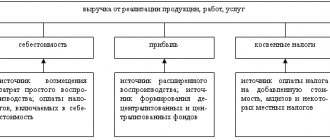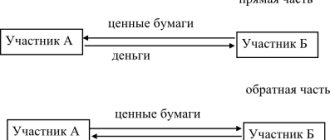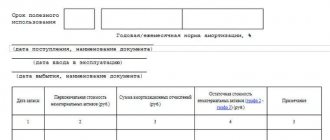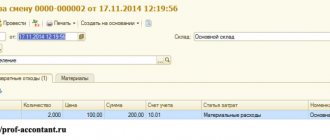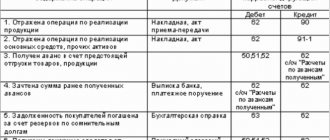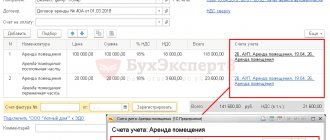The concept of sales of goods, works or services
The sale of products and services is regulated by tax legislation, namely Article 39 of the Tax Code of the Russian Federation. Legal regulation of the sale of goods, works, and services is carried out by the Tax and Civil Codes of the Russian Federation.
The definition of the concept of implementation is presented in Chapter 39 of the Tax Code of the Russian Federation. The chapter determines that sales can only be carried out by organizations and individual entrepreneurs. It is carried out on a reimbursable basis through the transfer of funds or the exchange of goods and services.
In other words, the rights to the property are transferred to the buyer. It is also possible to transfer services free of charge from one person to another. This implementation method is often used when working with non-profits and social enterprises.
The Tax Code of the Russian Federation gives the following definition: the sale of products, work or services by entities (organization or individual entrepreneur) is a paid transfer of property rights in the form of goods or results of the provision of services from one person to another person. The conditions for implementation and its types are provided for by the Tax Code.
Transfer of property rights free of charge is also possible, but only in cases where the transfer is secured by agreement. Such relations are also regulated by the norms of the Tax Code of the Russian Federation and the Civil Code of the Russian Federation.
For tax purposes, for accounting purposes, cost and profit are determined and a statement is drawn up that contains entries for all sales transactions.
To correctly draw up a document, an accountant or company manager must reliably determine cost and profit and make entries. Based on the results of such operations, the final profit (before tax) is determined, which is the subject of income tax.
Cost is the sum of all sales costs - raw materials, wages and related costs for the sale of goods, works and services. The correct preparation of tax returns for income tax, VAT, etc. depends on the correct posting to cost.
Violations in tax calculations entail penalties in the form of fines and penalties.
Expenses in sales accounting
After posting Dt 90.2 Kt 41, sales expenses are written off, which are included in the cost of production. The values of their amounts are located in account 44. The data is accumulated until the sale of goods and services occurs. Postings in this case, depending on the instructions of the accounting policy, can be drawn up as follows:
- Dt 90.2 Kt 44 – expenses related to sold products are written off;
- Dt 90 (subaccount of commercial expenses) Kt 44 - the amount of distribution costs of sold products is written off as selling expenses.
The second account assignment is only possible if this has been established in the company. A more typical and generally applicable method of writing off distribution costs is the first entry.
Place and moment of actual sale of goods, works or services
The definition of the second part of the Tax Code of the Russian Federation establishes the place and moment of actual implementation for individual taxes. The basis of Article 147 of the Tax Code of the Russian Federation recognizes the territory of the Russian Federation as the place of sale of products if the following clause is present: the goods must be located on the territory of Russia or in territories under the jurisdiction of the country, and it must be in the process of shipment and transportation.
In other words, the procedure for transferring goods that are transported or shipped to the seller is already controlled by the legal requirements for the sales operation.
Some differences are implied in the implementation of works and services, since these procedures are intangible. The territory of Russia is recognized as a place of sale of services in the following cases:
- if the work is related to real estate in the country (installation, restoration, repair work);
- if the work is related to movable property (cars, trucks, ships and aircraft on the territory of the Russian Federation (assembly, installation, processing and maintenance);
- services provided on the territory of the Russian Federation in the field of art, education, sports and tourism;
- the recipient of works and services carries out work on the territory of Russia.
The buyer’s place of business is recognized as the basis of his actual location on the territory of the Russian Federation on the basis of state registration documents.
In Determination No. 414-O dated November 24, 2005, the Constitutional Court of the Russian Federation indicates that paragraph 1 of Article 39 of the Tax Code of the Russian Federation cannot be considered as a provision that limits or violates the rights of taxpayers. The article is not of an independent regulatory nature.
The moment of sale for tax purposes is the date of receipt of income, regardless of their actual receipt in the seller’s accounts.
Sales of goods: retail postings
Direct sales of products to consumers are most often carried out using cash payments, but bank cards, settlement checks, commission agreements or installment payments can also be used. Cash registers, which are mandatory for use in enterprises working with the public, help track the volume of revenue at the cash register. The machine’s performance at the end of the day forms the amount of money brought in by the sale of goods. Postings - an example of attributing account amounts 50 to the financial result - are compiled as follows:
- Dt “Cashier” Kt “Revenue” – includes revenue from the sale of goods at sales prices, including VAT;
- Dt “Cost of sales” Ct “Retail goods” – the amount of the purchase price of goods is written off;
- Dt “Sales” (subaccount “VAT”) Ct “Calculations for VAT” – allocated VAT for payment.
We must not forget about the overhead costs of a trading enterprise, which are written off in this way:
- Dt “Cost of sales” Kt “Sales expenses” - the cost of sales includes the amount of distribution costs.
- When creating a separate subaccount on the account. 90 account assignment looks like this: Dt 90 (business expenses) Kt 44.
During the reporting month, accounting may make the described transactions more than once. Account 90 data broken down by subaccounts is accumulated for the period and then written off. The totality of debit turnover of the account. 90.2, 90.3, 90.4 and amounts on the loan account. 90.1 determines the financial result and is written off by posting Dt 90.5 Kt 99 or Dt 99 Kt 90.5. Account 90 has no balance at the end of the month.
What is recognized as the sale of goods, works or services
The following operations are recognized as sales of products, services and works for business tax purposes:
- transfer of ownership rights to goods on a reimbursable basis, including exchange;
- transfer of ownership rights to the results of work from one person to another;
- provision of services on a reimbursable basis;
- provision of services free of charge or transfer of ownership rights free of charge. At the same time, VAT is still calculated on such transactions (according to Article 146 of the Tax Code of the Russian Federation).
For example, a gift agreement, under which one of the parties transfers ownership or property rights to third parties free of charge. This operation is also recognized as a sale, which means an object of taxation arises (personal income tax and VAT).
For income tax (as opposed to VAT), sales income is recognized as proceeds from the sale of goods, proceeds from the sale of property rights and services. That is, in order to determine profit as an object of taxation, revenue is necessary, since transactions on a gratuitous basis are deprived of such an opportunity.
Accounting for implementation purposes is carried out according to regulatory documents unified by the state.
All operations have postings that determine the cost and profit on sales. At the same time, he draws up a statement indicating the amount of each specific transaction.
Identified violations of the legislation on accounting for sales transactions make it possible to determine the location of the violation in order to avoid tax penalties in the future.
Accounting for sales by core activity (products, goods, works and services)
All accounting operations arising in connection with sales in the main activity, the Chart of Accounts (approved by order of the Ministry of Finance of the Russian Federation dated October 31, 2000 No. 94n) prescribes to be carried out using account 90. Since both income and related expenses will fall here, account 90 will be formed financial result from sales.
Analytics organized on this account should make it possible to see sales data from each type of core activity. Trade organizations, in particular, should separate accounting entries for the sale of goods and the provision of services for their delivery to customers.
On the credit of account 90, as a result of posting Dt 62 Kt 90, income from each sale will be reflected in the full amount, including VAT and excise taxes. Since taxes should not be taken into account in the amount of income that forms the financial result, an entry will be made for their amount Dt 90 Kt 68, taking into account the accrual of taxes payable to the budget while simultaneously reducing sales income by their amount.
Also, expenses arising during the sale will be debited to account 90. This will be expressed by postings:
- Dt 90 Kt 43 (21, 40) in relation to the cost of products of own production;
- Dt 90 Kt 20 (23, 40) for the cost of work performed, services provided;
- Dt 90 Kt 41 at the accounting cost of goods sold;
- Dt 90 Kt 26 for general expenses;
- Dt 90 Kt 44 in relation to expenses for organizing sales.
In retail trade, goods can be accepted for registration not only at their actual cost, but also at the sales price (clause 13 of PBU 5/01, approved by order of the Ministry of Finance of Russia dated 06/09/2001 No. 44n), which leads to the appearance of additional posting Dt 41 Kt 42, which adds a markup amount to the supplier’s price. In this case, at the time of sale of the goods by posting Dt 90 Kt 42 reversal, the cost of its sale is reduced to the actual one.
From 2021, PBU 5/01 will no longer be in force and will be replaced by FSBU 5/2019 “Inventories”. You can start applying the standard ahead of schedule.
ConsultantPlus experts explained in detail how to account for reserves according to FAS 5/2019 standards. To do everything correctly, get trial access to the system and go to the Ready solution. It's free.
What is not recognized as the sale of goods, works or services
The Tax Code of the Russian Federation establishes operations that are not recognized as sales:
- currency circulation;
- transfer of property of the organization during reorganization;
- transfer of investment funds: deposits, shares;
- transfer of fixed assets to non-profit companies, if the latter are not engaged in entrepreneurial activities;
- return of the initial contribution to the participants of the companies upon their withdrawal from the membership;
- transfer of municipal residential real estate to individuals;
- other operations provided for by the Tax Code.
Types of services
The result of work performed and services provided is included in the implementation. Such relations are regulated by the Civil Code of the Russian Federation under Chapter 37. Sales arise when concluding a purchase and sale agreement or a work contract. In addition, there are other types of contracts.
Modern legislation defines three types of services: actual, legal and financial. In addition to the listed types of contracts, the following are recognized as implementation:
- income from rental property;
- exchange transactions without concluding a contract;
- transfer of property rights of the organization on account of dividends (for VAT);
- receipts when calculating taxes using the simplified tax system;
- transfer of goods to pay off debts.
Operations for the return of debt funds are not recognized as sales for VAT purposes.
Sales of finished products of the enterprise
Sales of finished products of the enterprise: analysis, volumes, costs, organization, planning
Insufficient knowledge of the market very often causes deterioration in the competitiveness of products, and accordingly, turnover decreases and volumes and revenues from product sales deteriorate. Therefore, in the business plan it is necessary to indicate that you know the market conditions very well and have a methodology for constant and continuous market analysis, by means of which you have established your strategic goals and drawn up your concept for the sale of finished products of the enterprise and the costs associated with its sale.
Finished products are the final product of an enterprise's production. These are products and products that are fully processed, meet the technical specifications and standards, accepted by the laboratory or technical control and are listed in the finished product warehouse.
The organization of product sales and its subsequent analysis is of key importance. Product sales are the most important economic performance indicator, which determines the feasibility and efficiency of the enterprise. The sales volume includes shipped and released products, regardless of whether funds are credited to the current account or received in the form of cash.
Thus, the sale of finished products is the completion of the circulation of funds at the enterprise, which makes it possible to fully fulfill existing obligations to the state. budget, timely pay off loans, employees and workers, suppliers and contractors and compensate for costs incurred. Failure to fulfill obligations related to the sale of finished products to its customers leads to a slowdown in the turnover of current assets, fines for failure to fulfill obligations to customers under contracts, delayed receipt of payments, and a deterioration in the financial condition and competitiveness of the enterprise.
The main tasks of selling finished products at the enterprise:
- − correct and timely documentation of released and shipped products (services, works), clear organization of cash settlements with customers;
- − subsequent monitoring of the implementation of supply contracts that were concluded with suppliers regarding the range and volume of products sold;
- − accurate and timely calculation of amounts received as a result of product sales.
- − systematic monitoring of the sale of finished products, the condition of inventories and their safety in warehouses, the volume of work performed and services provided.
The successful completion of these tasks largely depends on the rhythm of the enterprise’s work, the competent organization of product sales, and the timely execution of transactions in documents.
Release transfers finished products from production into circulation. This process is recorded in documents such as delivery notes, invoices, acceptance certificates, statements, contracts and others.
The release and shipment of finished products to Beltakt LLC is formalized:
- — supply contract with specifications;
- - invoice, in accordance with which products are released.
- - an invoice, which is then transferred to the accounting department.
An invoice and delivery note are issued on the basis of an agreement with customers and buyers with the obligatory indication of the assortment and quantity of products, the name of the buyer, as well as the cost per unit of product.
The materially responsible person (MRP) completes all the necessary products in accordance with the documents for shipment of goods and transfers the necessary documentation to send the products to the forwarder.
Thus, planning product sales is a very important step in developing a business plan and must be reflected in your plan. Careful and constant market analysis is a key prerequisite for successful marketing. The development and implementation of new services and products often fails due to lack of market interest or due to overestimation of market potential. You can often hear that market research is too expensive, or that there is a lack of data on a particular market sector.
Try to show the reader of your business plan that you are able to analyze the market for your product without the involvement of outside consultants or market research. Briefly list the sources on which your systematic analysis of market conditions is based.
You can obtain the information you need by attending specialized workshops and trade fairs, talking with customers, experts and suppliers, using primary research from the economic section of daily newspapers, specialist magazines or industry analyzes prepared by the Chamber of Commerce and Industry and the Union of Entrepreneurs, from the official industry statistics and the Internet.
Composition of financial services
A financial service is a service whose control base is determined by Articles 807, 834 and 927 of the Civil Code of the Russian Federation. These services include:
- services for providing loans and credits;
- services for registration of deposits and shares;
- insurance and assignment of monetary claims (collection) services.
Thus, implementation is a complex legal procedure, so its production requires a good knowledge of the law. The basis for determining taxes for business purposes is recognized as such according to Articles 39-41 of the Civil Code of the Russian Federation.
When calculating income tax, VAT and other types of taxes and fees, any taxpayer must rely on tax legislation.

